
Suspended Animation #364
Clarence Nash was born December 7th, 1904, in Watonga, Oklahoma, roughly three years before it even became a state of the union. He never grew to be taller than 5-foot-2. He was raised on a farm in Independence, Missouri.
At school, Nash said, “It was a big thing for the kids to try to outdo one another imitating animal sounds. By the age of 12, I could do the sounds of dogs, cats, baby chicks, horses, pigs, raccoons, frogs, baby coyotes and a lot of birds.”
 It was as this time that he acquired his final childhood pet, a baby billy goat named “Mary”.
It was as this time that he acquired his final childhood pet, a baby billy goat named “Mary”.
“When I got the goat, it was only a couple of days old and I had to feed it with a baby bottle. When I stopped feeding it, it would cry like a frightened little girl,” recalled Nash who was challenged to imitate the unique sound which he did to the delight of his schoolmates.
He also worked at trying to convert the sound into simple words. For a school talent show when he was 13, he recited the poem “Mary Had a Little Lamb,” in the voice of the goat, and received wild applause from the audience.
Eventually, Nash dropped out of school as a teen so he could tour the Midwest as a mandolin player in the Alamo Quintet and an “animal impressionist” on the Redpath Chautauqua and Lyceum circuit. His most popular encore was doing “Mary Had a Little Lamb” in the voice of his billy goat. At the time, Nash felt that vaudeville would last forever, but was given a shock as it died out in the late 1920s.
Nash married his 18-year-old sweetheart, Margie Seamans, on January 25th, 1930, and moved to San Francisco looking for a “normal” job, but in the beginning of the Depression that was not easy. So the couple moved to Los Angeles where Nash found work doing his animal impressions as part of the KHJ local radio show, The Merry Makers that led to a job with the Adohr Milk Company when they heard him perform.
To promote its brand of milk, Adohr hired Nash as “Whistling Clarence, the Adohr Bird Man.” He would drive a miniature open-topped milk wagon (decorated with games, plugs for the milk and Clarence’s name with painted black silhouettes of different birds underneath) pulled by a team of miniature horses. He would go to local schoolyards and assemblies to entertain children with his bird calls and animal sounds as well as giving out treats like a small tape measure with Adohr’s name on it. He was attired as a standard Adohr milk man.
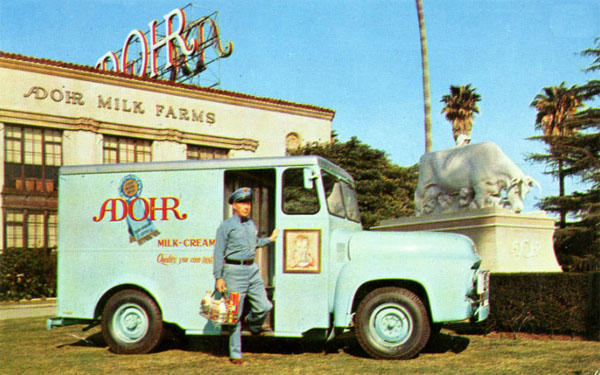
After two years working at Adohr, as a favor to a friend in San Francisco who missed hearing him on the radio, he did one free show on the local The Merry Makers radio show, unaware that it was that particular performance that Walt Disney was casually listening to at the moment.
Nash’s friends had urged him to audition for the Disney Studios since they had announced they were looking for someone to provide animal sounds for their animated short cartoons. Two days after the radio broadcast, Nash found himself at the Disney Studios.
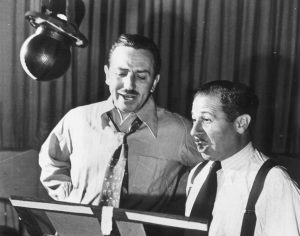
Walt Disney, the voice of Mickey Mouse, stands next to Clarence Nash in a sound recording room, 1945. (Photo by PhotoQuest/Getty Images)
Nash was still wearing his milk man outfit because after the audition, he had to go back to work. He performed all his animal sounds, his bird calls and then began to recite “Mary Had a Little Lamb” as his big finish. Jackson stopped him for a moment. He switched on the intercom which went directly to Walt’s office and then asked Nash to continue.
Within moments, Walt rushed into the Jackson’s office and said excitedly, “That’s our talking duck!”
Nash was smart enough not to say it was the voice of a goat. Walt was thinking of doing a cartoon with a girl duck, but it hadn’t quite gelled as a story yet.
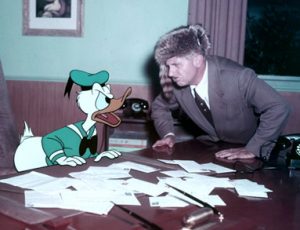 As he was leaving, Nash ran into Disney storyman Ted Osborne, who had produced the recent episode of the radio show featuring Nash and said, “Hey, Walt, heard you that night and he was going to look you up.”
As he was leaving, Nash ran into Disney storyman Ted Osborne, who had produced the recent episode of the radio show featuring Nash and said, “Hey, Walt, heard you that night and he was going to look you up.”
Apparently, during a break at a late-night story meeting, Osborne had turned on the show to see how it was going and Walt heard Nash.
Nash was not hired, but put on a retainer for a year so he kept his job with the dairy. His first actual voice work for Disney was supplying bird sounds in the Mickey Mouse short The Pet Store (1933) and he kept being tossed similar little bits.
Walt’s former partner, Ub Iwerks, had left to start his own animation studio and had also heard of Nash’s expertise. He asked Nash to come in and audition to do a voice or voices for his new cartoon short in production, The Little Red Hen, based on the children’s story of a hen looking for help to plant, harvest and grind her corn.
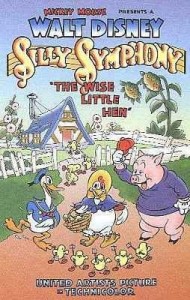 Nash wisely phoned to ask Walt’s permission, but Walt was unavailable. Ironically, Walt also had a version of the same story, titled The Wise Little Hen, in development and was planning to have Nash do the voice of the duck.
Nash wisely phoned to ask Walt’s permission, but Walt was unavailable. Ironically, Walt also had a version of the same story, titled The Wise Little Hen, in development and was planning to have Nash do the voice of the duck.
Walt called Nash back roughly a dozen times but couldn’t reach him since he was out on the streets doing his job, but finally left a message for Nash not to do anything for the Iwerks cartoon.
Nash got called into a story meeting for The Wise Little Hen and met Disney storyman Pinto Colvig who told him, “Walt told me about your calling about your going over to Iwerks. He said, ‘I like that loyalty in that guy, I’m going to put him on the payroll’.”
After the story meeting, Walt asked Nash to come to his office to talk about revising the retainer agreement so that Nash could still work for Adohr while doing voices at Disney.
As Nash told animation historian Milt Gray, “I told Walt, ‘I’d rather work for just one organization, I don’t want to work for two people.’ ‘OK, we’ll start you at the first of the year.’ ‘Walt, if you don’t mind, I’d like to come to work sooner’.”
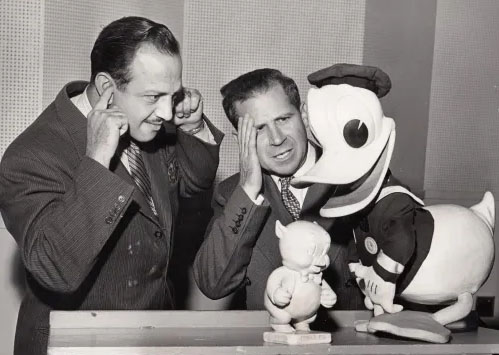
Mel Blanc and Clarence Nash appear together on radio’s The Burns And Allen Show in the 1940s. (photo courtesy of Leonard Maltin)
On December 2nd, 1933, Nash became Disney’s 125th employee. He was earning the same amount he made at Adohr: $35 a week.
Nash could not put in enough hours just doing voices to justify that full-time salary, so he often found himself temporarily in side jobs from accepting artist portfolios and processing them to being a chauffeur for visiting celebrities.
His wife’s reaction to him being hired to do the voice of a duck was “That’s nice but it probably won’t last.”
“Donald lasted a lot longer than I thought he would,” said Nash. “I figured he was just like any other cartoon character who would eventually run his course. It never occurred to me he would last over 50 years.”


 Jim Korkis is an internationally respected animation historian who in recent years has devoted his attention to the many worlds of Disney. He was a columnist for a variety of animation magazines. With his former writing partner, John Cawley, he authored several animation related books including The Encyclopedia of Cartoon Superstars, How to Create Animation, Cartoon Confidential and Get Animated’s Animation Art Buyer’s Guide. He taught animation classes at the Disney Institute in Florida as well as instructing classes on acting and animation history for Disney Feature Animation: Florida.
Jim Korkis is an internationally respected animation historian who in recent years has devoted his attention to the many worlds of Disney. He was a columnist for a variety of animation magazines. With his former writing partner, John Cawley, he authored several animation related books including The Encyclopedia of Cartoon Superstars, How to Create Animation, Cartoon Confidential and Get Animated’s Animation Art Buyer’s Guide. He taught animation classes at the Disney Institute in Florida as well as instructing classes on acting and animation history for Disney Feature Animation: Florida.




















































That Blanc & Nash photo is priceless!
Very nice article (as always) Jim, and Jerry!
Nice to see you’re doing well Tony. Hope Donald’s still active even with Ducktales 2017 over with just the Rudish Mickey shorts and Mickey Mouse Funhouse having him right now.
For anyone who subscribes to the New Yorker online, here’s a 1975 profile of Nash:
https://www.newyorker.com/magazine/1975/12/29/the-quack-and-disney
Did Clarence Nash also voice Peter Pig in “The Wise Little Hen”?
I’ve always been amused by the little white shoes the chicks wear in that cartoon. I suppose it was done just to save the expense of drawing all those toes.